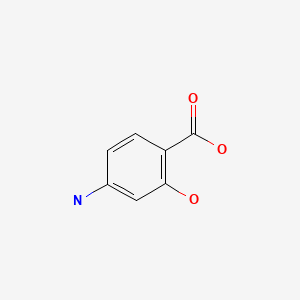Attribution Statement: LactMed is a registered trademark of the U.S. Department of Health and Human Services.
NCBI Bookshelf. A service of the National Library of Medicine, National Institutes of Health.
Drugs and Lactation Database (LactMed®) [Internet]. Bethesda (MD): National Institute of Child Health and Human Development; 2006-.
CASRN: 65-49-6

Drug Levels and Effects
Summary of Use during Lactation
Limited information indicates that maternal aminosalicylic acid therapy produces low levels in milk and would not be expected to cause any adverse effects in breastfed infants, especially if the infant is older than 2 months. Exclusively breastfed infants should be monitored for rare instances of jaundice, gastrointestinal disturbances, hypokalemia, thrombocytopenia, hemolysis and hypokalemia if this drug is used during lactation.[1]
Drug Levels
Maternal Levels. One woman who was lactating, but not breastfeeding (time postpartum not stated) took a single 4 gram oral dose of aminosalicylic acid. A peak milk level of 1.1 mg/L occurred at 3 hours after the dose. The drug's half-life in milk was estimated to be 2.5 hours.[1] Using these data, a fully breastfed infant would receive a maximum of about 0.25% of the maternal weight-adjusted dosage.
Infant Levels. Relevant published information was not found as of the revision date.
Effects in Breastfed Infants
Aminosalicylic acid was used as part of multi-drug regimens to treat 2 pregnant women with multidrug-resistant tuberculosis throughout pregnancy and postpartum. Their two infants were breastfed (extent and duration not stated). At age 1.8 and 4.6 years, the children were developing normally, except for except for a mild speech delay in one at age 1.8 years, and failure to thrive in the other, possibly due to tuberculosis contracted after birth.[2]
Effects on Lactation and Breastmilk
Relevant published information was not found as of the revision date.
References
- 1.
- Holdiness MR. Antituberculosis drugs and breast-feeding. Arch Intern Med 1984;144:1888. Letter. PMID: 6548112. [PubMed: 6548112]
- 2.
- Drobac PC, del Castillo H, Sweetland A, et al. Treatment of multidrug-resistant tuberculosis during pregnancy: long-term follow-up of 6 children with intrauterine exposure to second-line agents. Clin Infect Dis. 2005;40:1689–92. [PubMed: 15889370]
Substance Identification
Substance Name
Aminosalicylic Acid
CAS Registry Number
65-49-6
Disclaimer: Information presented in this database is not meant as a substitute for professional judgment. You should consult your healthcare provider for breastfeeding advice related to your particular situation. The U.S. government does not warrant or assume any liability or responsibility for the accuracy or completeness of the information on this Site.
- User and Medical Advice Disclaimer
- Drugs and Lactation Database (LactMed) - Record Format
- LactMed - Database Creation and Peer Review Process
- Fact Sheet. Drugs and Lactation Database (LactMed)
- Drugs and Lactation Database (LactMed) - Glossary
- LactMed Selected References
- Drugs and Lactation Database (LactMed) - About Dietary Supplements
- Breastfeeding Links
- PubChem SubstanceRelated PubChem Substances
- PubMedLinks to PubMed
- Review Mesalamine.[Drugs and Lactation Database (...]Review Mesalamine.. Drugs and Lactation Database (LactMed®). 2006
- Review Aspirin.[Drugs and Lactation Database (...]Review Aspirin.. Drugs and Lactation Database (LactMed®). 2006
- Review Salicylic Acid.[Drugs and Lactation Database (...]Review Salicylic Acid.. Drugs and Lactation Database (LactMed®). 2006
- Review Valproic Acid.[Drugs and Lactation Database (...]Review Valproic Acid.. Drugs and Lactation Database (LactMed®). 2006
- Review Glycolic Acid.[Drugs and Lactation Database (...]Review Glycolic Acid.. Drugs and Lactation Database (LactMed®). 2006
- Aminosalicylic Acid - Drugs and Lactation Database (LactMed®)Aminosalicylic Acid - Drugs and Lactation Database (LactMed®)
Your browsing activity is empty.
Activity recording is turned off.
See more...
